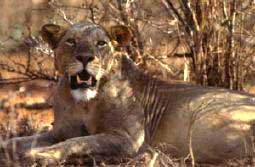Explaining Tsavo’s Maneless Man-Eaters

Image: John Weinstein/Courtesy of the Field Museum
The phrase “king of the jungle” invariably conjures up the image of a majestic, tawny cat with a fluffy mane framing its face. But in fact not all male lions have big hair. In Kenya’s Tsavo National Park–famed for the man-eating lions that reportedly terrorized railroad workers there in the late 1800s–a number of males lack manes altogether. Exactly why this should be the case–or why any lions should have manes, for that matter–has been difficult to explain. To that end, the results of a new study, published online today by the Canadian Journal of Zoology, could prove insightful.
Over the years, researchers have put forth several social hypotheses aimed at explaining the main function of the mane in these group-living felines, ranging from intimidation (a big mane makes an animal look bigger) to physical protection for the head and neck areas from other lions to sex appeal. At the same time, however, manes are expensive: they offer unnecessary and perhaps harmful insulation to beasts in hot areas, they make the animals more conspicuous to both prey and competitors, and all that extra hair provides more stuff for thorns and brambles to latch onto.
To shed some light on the matter, Roland Kays of the New York State Museum in Albany and Bruce Patterson of the Field Museum in Chicago set out to test one of the social hypotheses: that mane size should vary as a function of female group size. According to this model, increased female group size should ratchet up the sexual selection pressure for long, flowing manes on males. Males with reduced or nonexistant manes, in contrast, should predominate in areas characterized by smaller female groups.
Observations of the Tsavo lions did not bear these predictions out. The researchers found that average female group size was large for the species. Yet most males were maneless or retained only remnant tufts on their head or neck. The more likely explanation for Tsavo’s maneless males, Kays and Patterson conclude, is that the blisteringly hot, arid, thornbrush-covered Tsavo habitat makes mane maintenance too costly.
The researchers further note that in contrast to savannah-dwelling populations, the prides observed in Tsavo consisted of a lone male defending a group of females. “How single, maneless males are able to hold relatively large groups of females remains unknown,” they write. But it may be that these males have higher testosterone levels, which could account for both their “baldness” and their ability to single-handedly fend off groups of challengers.
Media Contact
All latest news from the category: Life Sciences and Chemistry
Articles and reports from the Life Sciences and chemistry area deal with applied and basic research into modern biology, chemistry and human medicine.
Valuable information can be found on a range of life sciences fields including bacteriology, biochemistry, bionics, bioinformatics, biophysics, biotechnology, genetics, geobotany, human biology, marine biology, microbiology, molecular biology, cellular biology, zoology, bioinorganic chemistry, microchemistry and environmental chemistry.
Newest articles

NASA: Mystery of life’s handedness deepens
The mystery of why life uses molecules with specific orientations has deepened with a NASA-funded discovery that RNA — a key molecule thought to have potentially held the instructions for…

What are the effects of historic lithium mining on water quality?
Study reveals low levels of common contaminants but high levels of other elements in waters associated with an abandoned lithium mine. Lithium ore and mining waste from a historic lithium…

Quantum-inspired design boosts efficiency of heat-to-electricity conversion
Rice engineers take unconventional route to improving thermophotovoltaic systems. Researchers at Rice University have found a new way to improve a key element of thermophotovoltaic (TPV) systems, which convert heat…



